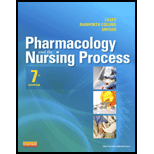
To describe:
Extravasation and other side effects caused by cell cycle–nonspecific and miscellaneous anti-neoplastics and antidotes.
Concept introduction:
Cancer cells are characterized by the uncontrolled proliferation of abnormal cells, invasion, metastasis, and anti-apoptosis. Chemotherapeutic drugs are broadly classified into two categories based on targeting the phases of the cell cycle (cell cycle––specific drugs and cell cycle–non-specific drugs). Alkylating drugs are cell cycle–non-specific anticancer drugs. They are used to treat a wide range of cancers, including solid and hematological tumors. Alkylating drugs are commonly categorized into three namely classic alkylators (for example, chlorambucil and cyclophosphamide), nitrosoureas (for example, carmustine and lomustine), and miscellaneous alkylators (for example, altretamine and busulfan). The alkylating drugs prevent cancer progression by inhibiting DNA synthesis through the formation of covalent bonds with DNA bases. The major adverse effects of alkylating drugs are pulmonary fibrosis, nephrotoxicity, neurotoxicity, ototoxicity, and bone marrow suppression.
Want to see the full answer?
Check out a sample textbook solution
Chapter 46 Solutions
Pharmacology and the Nursing Process
- overview of the neurological system, cranial nerves and what part of the body it innervatesarrow_forwarddifferentiate structure and function of the peripheral vascular system. what are the normal and abnormal findings of the peripheral arterioles and peripheral venous systemarrow_forwardAn overview of the skin, hair and nails epidermal appendages normal and abnormal findingsarrow_forward
- differentiate the twelve cranial nerves and how to test themarrow_forwardWhat are the nursing interventions for patients with GI problems ? What is the priority ?arrow_forwardAdult Nutrition Assessment Date of consultation: 3/2/25 Reason for Nutrition Assessment: Mrs. Clover was referred to the RD from the ER physician; patient experiencing weight loss, SOB & Edema Nutrition Assessment Data 69 YOF Ht 157 cm, Wt 53 kg. BMI 21.7 Usual wt 55 kg Heart: slight physiologic murmur; lungs: clear; extremities: 3+ edema to bilateral lower legs; elevated BP, abdomen: soft, nontender, active bowel sounds; neurologic: unremarkable; skin: diminished skin tugor. Biochemical Data BUN 72, Creatinine 4.6, Calcium 7.2, Phosphorus 7.3, glucose 105, BNP 720, Albumin 2.0, Na 125, K 3.3, CI 93. Hgb 11.5, Hct 33.2, ALT 29, AST 36, Alkaline phosphatase 120, other relevant labs pending result. Medications Include inhalers, Cymbalta, Neurontin, Seroquel, and topiramate, prilosec, solumedrol, rocephin, zithromax, NaCl 0.45%+50 MEQ sodium bicarbonate @100 ml/hr. No history of herbal supplements. Since her pneumonia diagnosis several days ago, she has felt too weak to prepare meals, she…arrow_forward
- Assuming you are a community health nurse, choose a community of your own and perform practically the following and report your findings: a. Community Assessment b. Community Diagnosisarrow_forwardDescribe practically how you would use a standing order in the diagnosis and treatment of a 10-year-old primary school pupil with a complaint of haematuria at the end of the urine.arrow_forwardSimple explanations, please. B. Why is an accurate diagnosis of malnutrition important? H. Is BMI a food indicator of malnutrition? I. Can an overweight/obese patient develop malnutrition? Why or why not?arrow_forward
- How is the severity of malnutrition determined based off the table? Simple explanation please.arrow_forwardDiscuss on: 1. Peptic Ulcer disease Aetiology 2. Classification of drugs used in the treatment of PUD 3. Triple therapy of PUD 4. Drugs Contraindicated in PUDarrow_forwardCATH LAB FUNDAMENTALS I WORKSHEET #2 Patient #1 NAME: AO 232/112 M CaO2 ml/L LV 232/25 CvO2 ml/L RA M 17 C.O. L/Min RV 61/17 S.V. ml/beat PA 61/25 M C.I. L/Min/M2 PAW M 25 S.I. ml/beat/M2 Hgb 10.3 S.V.R Dynes/sec/cm5 Hct % T.P.R Dynes/sec/cm5 PA Sat 56% P.V.R Dynes/sec/cm5 AO Sat 81% BSA M2 HR 113 BPM 02 Cons. 233 ml/min Ht _5_ft_10_in Wt. _330_lbs Patient#2 AO 78/46 M CaO2 ml/L LV 78/10 CvO2 ml/L RA M---7 C.O. L/Min RV 21/7 S.V. ml/beat PA 21/12 M C.I. L/Min/M2 PAW M- 12- S.I. S.V.R ml/beat/M2 Dynes/sec/cm5 Hct 45%…arrow_forward
 Phlebotomy EssentialsNursingISBN:9781451194524Author:Ruth McCall, Cathee M. Tankersley MT(ASCP)Publisher:JONES+BARTLETT PUBLISHERS, INC.
Phlebotomy EssentialsNursingISBN:9781451194524Author:Ruth McCall, Cathee M. Tankersley MT(ASCP)Publisher:JONES+BARTLETT PUBLISHERS, INC. Gould's Pathophysiology for the Health Profession...NursingISBN:9780323414425Author:Robert J Hubert BSPublisher:Saunders
Gould's Pathophysiology for the Health Profession...NursingISBN:9780323414425Author:Robert J Hubert BSPublisher:Saunders Fundamentals Of NursingNursingISBN:9781496362179Author:Taylor, Carol (carol R.), LYNN, Pamela (pamela Barbara), Bartlett, Jennifer L.Publisher:Wolters Kluwer,
Fundamentals Of NursingNursingISBN:9781496362179Author:Taylor, Carol (carol R.), LYNN, Pamela (pamela Barbara), Bartlett, Jennifer L.Publisher:Wolters Kluwer, Fundamentals of Nursing, 9eNursingISBN:9780323327404Author:Patricia A. Potter RN MSN PhD FAAN, Anne Griffin Perry RN EdD FAAN, Patricia Stockert RN BSN MS PhD, Amy Hall RN BSN MS PhD CNEPublisher:Elsevier Science
Fundamentals of Nursing, 9eNursingISBN:9780323327404Author:Patricia A. Potter RN MSN PhD FAAN, Anne Griffin Perry RN EdD FAAN, Patricia Stockert RN BSN MS PhD, Amy Hall RN BSN MS PhD CNEPublisher:Elsevier Science Study Guide for Gould's Pathophysiology for the H...NursingISBN:9780323414142Author:Hubert BS, Robert J; VanMeter PhD, Karin C.Publisher:Saunders
Study Guide for Gould's Pathophysiology for the H...NursingISBN:9780323414142Author:Hubert BS, Robert J; VanMeter PhD, Karin C.Publisher:Saunders Issues and Ethics in the Helping Professions (Min...NursingISBN:9781337406291Author:Gerald Corey, Marianne Schneider Corey, Cindy CoreyPublisher:Cengage Learning
Issues and Ethics in the Helping Professions (Min...NursingISBN:9781337406291Author:Gerald Corey, Marianne Schneider Corey, Cindy CoreyPublisher:Cengage Learning





